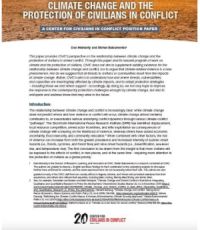Climate Change and the Protection of Civilians in Conflict

A CENTER FOR CIVILIANS IN CONFLICT POSITION PAPER
23 August 2023
Description: This paper provides CIVIC’s perspective on the relationship between climate change and theprotection of civilians in armed conflict. Through this paper and its nascent program of work onclimate and the protection of civilians, CIVIC does not aim to supplement existing evidence for therelationship between climate change and conflict, nor to argue that climate-related violence is a newphenomenon. Nor do we suggest that all threats to civilians or communities result from the impactsof climate change. Rather, CIVIC’s aim is to understand how and where threats, vulnerabilities,and capacities are meaningfully affected by climate impacts, and to adapt protection strategies– including those we and others support - accordingly. By doing so, we not only hope to improvethe response to the contemporary protection challenges wrought by climate change, but also to anticipate and address those that may arise in the future.
Author(s): Dan Mahanty and Stefan Bakumenko
Publisher: Centre for Civilians in Conflict
Date: 23 August 2023
Publication Page: https://civiliansinconflict.org/publications/policy/brief-climate-change-and-the-protection-of-civilians-in-conflict/
The relationship between climate change and conflict is increasingly clear: while climate change does not predict where and how violence or conflict will occur, climate change almost certainly contributes to, or exacerbates various underlying conflict dynamics through various climate-conflict “pathways”.
The Stockholm International Peace Research Institute (SIPRI) has identified displacement, local resource competition, armed actor incentives, and elite exploitation as consequences of climate change with a bearing on the likelihood of violence, whereas others have added economic uncertainty, food insecurity, and community relocation. When combined with other factors, the risk of violence can increase from both the greater prevalence and increased intensity of sudden onset hazards (i.e., floods, cyclones, and forest fires) and slow onset hazards (i.e., desertification, sea-level rise, and temperature rise). The first conclusion to be drawn from this insight is that more civilians will be exposed to the effects of conflict, in new places, and at the same time – requiring more attention to the protection of civilians as a global priority.
Read the full brief here.